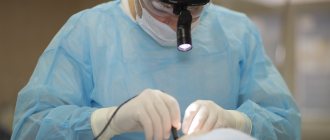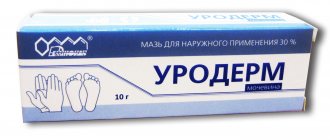An umbilical hernia appears as a protrusion in the navel area that disappears or decreases in size when you lie down.
An umbilical hernia may be accompanied by discomfort, abdominal pain, and nausea.
The main cause of this disease is the weakening of the umbilical ring and the formation of a hole in the anterior abdominal wall, through which internal organs (intestines, greater omentum) emerge under the skin.
An umbilical hernia develops more often in women, which is associated with stretching of the umbilical ring during pregnancy.
Other causes of umbilical hernia include heavy lifting, chronic constipation, and obesity.
How do hernias form?
Hernias occur in the area of “weak spots” of the anterior abdominal wall, under the influence of intra-abdominal pressure. Factors that cause its increase are called producing factors and include: physical activity, cough, childbirth and all those cases when the abdominal press tenses.
“Weak spot” is the area of the abdominal wall where the muscular aponeurotic part is most thinned. This may be the place of muscle attachment to the aponeurosis or physiological openings (inguinal rings, umbilical ring).
An increased risk of hernias is observed in people with predisposing factors: connective tissue weakness syndrome, damage to the nerves innervating the abdominal wall, as well as the presence of postoperative scars.
What does a hernia consist of?
All hernias, regardless of location and size, have a common structure and consist of the following components:
- A hernial orifice is a defect of the anterior abdominal wall, mainly in the aponeurosis. Through them, the internal organs leave the abdomen and end up under the skin. If the hernial orifice is wide, then through it the contents can freely return to the abdominal cavity.
- Hernial sac is a sheet of stretched peritoneum covering organs that extend beyond the abdominal cavity through the hernial orifice. The hernial sac is covered with several membranes, these also include subcutaneous tissue and skin.
- The contents of the hernial sac are the internal organs or their individual parts that extend beyond the abdominal cavity through the hernial orifice.
Do you want to get rid of a hernia quickly and permanently?
You're lucky to have found us. Contact us for advice.
- We will conduct an in-depth diagnosis of the condition of your abdominal cavity
- We will select for you the optimal treatment method from the entire range of modern high-tech surgical techniques
- Our highly qualified specialists - candidates and doctors of medical sciences - will perform the operation using the latest technologies, expensive specialized equipment and materials
- Your stomach will become healthy and beautiful, and traces of the intervention will be completely invisible to prying eyes
- We will carry out follow-up examinations and monitor your abdominal condition for six months to ensure there is no recurrence (free of charge)
What types of hernias are there?
Depending on the anatomical location, external and internal hernias are distinguished. External ones include:
- Umbilical hernia.
- Inguinal hernia.
- Hernia of the white line of the abdomen.
- Postoperative hernia.
- Paracolostomy hernia.
- Lumbar hernia.
- Perineal hernia.
- Obturator hernia.
- Hernia of the xiphoid process.
- Sciatic hernia.
Hernias that form inside the abdominal cavity are considered separately. With such hernias, internal organs can be located in pockets of the peritoneum or penetrate into the chest cavity through the openings of the diaphragm.
Depending on the size of the hernia, they are divided into:
- Small: hernial orifice less than 4 cm
- Medium: hernial orifice from 4 to 10 cm
- Large: hernial orifice larger than 10 cm
Hernias are also classified according to the degree of development:
- initial - a small depression is identified in a weak spot of the abdominal wall - a triggering factor for the formation of a hernia;
- canal - internal organs begin to sink into the hernial opening;
- complete - the internal organs have passed through the hernial orifice and are located under the skin.
According to the clinical course, hernias are divided into:
- reducible - the contents of the hernial sac move freely from the abdominal cavity to the hernial sac and back.
- irredeemable.
- strangulated - a condition in which the hernial orifice puts pressure on the structures of the released organ, which leads to disruption of its blood supply and can lead to necrosis. There are: elastic strangulation, fecal strangulation, parietal strangulation, retrograde strangulation, Meckel's diverticulum strangulation, Broca's hernia.
What are the symptoms of a hernia?
In the initial stages, a hernia may manifest itself as discomfort or slight pain during physical activity at the site of hernia formation. As the aponeurosis thins or the tissues of the anterior abdominal wall weaken, a painless protrusion appears, disappearing when pressure is applied to it. With each new episode of increased intra-abdominal pressure, the hernial orifice will increase in size, and the sac will stretch due to an increase in the volume of contents.
External abdominal hernias that occur without complications are characterized by such general symptoms as: the presence of a hernial protrusion, discomfort in the hernia area, dysfunction of the organs that make up the hernial contents.
Rehabilitation period
With open surgery, the patient's recovery period lasts longer than with laparoscopy, since the operation affects more tissue.
After open surgery:
- The patient remains in the hospital for one to two weeks.
- For the first 5-7 days, the patient is treated with stitches and bandaged.
- The patient wears stitches for 2 weeks.
- For the first six months, the patient is prohibited from physical activity, standing for long periods of time, or lifting and carrying loads of more than 5 kilograms.
- After 8 months or later, the patient is prescribed physical therapy to restore and strengthen the abdominal muscles.
After laparoscopic surgery:
- The patient remains in the hospital for 3-7 days.
- Within 3-7 days, the patient’s wounds are treated and bandaged.
- The stitches are removed after a week.
- For the first six months, the patient is prohibited from physical activity, standing for long periods of time, or lifting and carrying loads of more than 5 kilograms.
- After 8 months, the patient is prescribed physical therapy to restore and strengthen the abdominal muscles.
Why is a hernia dangerous?
Any hernia is dangerous for the development of complications. The most serious complication of a hernia is strangulation. It occurs when the blood supply to the contents of the hernial sac is disrupted and tissue necrosis occurs.
An equally serious complication is intestinal obstruction. As a result of the prolonged presence of intestinal loops inside the hernial sac, they are compressed, the movement of intestinal contents through them is disrupted, and intestinal obstruction forms.
It is very important to understand that the development of complications can occur suddenly, against the background of complete well-being: on vacation, at the dacha, while traveling - in situations where qualified medical care is difficult to access or not available at all. Treatment of hernia complications requires emergency intervention, and delay can lead to a sharp deterioration in a person’s condition and significantly worsen the prognosis of delayed treatment.
Therefore, it is better to get rid of the hernia before complications develop.
Complications
Possible complications when using meshes for surgical treatment of a hernia can arise in cases where the operation was performed incorrectly - an infection got into the wound, the endoprosthesis was poorly installed, the mesh was chosen of the wrong size.
If the operation is performed incorrectly, the following complications may occur:
- possible occurrence of extrusion and adhesions when the mesh is displaced;
- development of infections, suppuration and fistulas when germs or bacteria enter during surgery;
- discomfort when installing a larger mesh than necessary;
- relapse when installing a mesh that is smaller than necessary;
- bleeding due to insufficient wound suturing and improper installation of the endoprosthesis.
If the mesh endoprosthesis was installed correctly, then there should be no complications after the operation.
Despite the fact that the mesh endoprosthesis is hypoallergenic, in very rare cases the patient’s body may not accept the mesh and react to it with inflammatory and allergic reactions. In this case, the patient may experience vomiting and general intoxication of the body.
Hernia treatment
It is only possible to completely get rid of a hernia through surgery. There are also conservative methods to alleviate the condition of a hernia, but their use is possible only if there are contraindications to surgery.
Contraindications to elective surgical treatment include severe concomitant diseases, malignant processes in advanced stages, acute diseases and pregnancy. It is important to note that complicated hernias must be operated on urgently for health reasons.
The smaller the size of the hernia, the easier the operation for both the surgeon and the patient. In turn, the treatment of giant hernias represents a major surgical problem and requires the use of non-standard approaches to its elimination.
Hernioplasty (hernia repair) is the name of an operation to “liquidate” a hernia with plastic surgery of a defect in the anterior abdominal wall.
Indications and contraindications
Installation of mesh endoprostheses is indicated:
- for hernias repaired surgically;
- with injuries to the chest wall;
- with damage to the diaphragm;
- for soft tissue defects;
- to strengthen traumatic and surgical wounds.
The use of surgical mesh for hernia is contraindicated:
- during pregnancy;
- when the patient is under 5 years of age;
- for disorders of the cardiovascular system;
- after a stroke;
- for respiratory disorders;
- during exacerbations of chronic diseases.
In order to find out exactly whether a mesh endoprosthesis is indicated or contraindicated, it is necessary to consult with a surgeon, providing him with full information about the disease, health status, current and past diseases.
What are the methods of anterior abdominal wall plastic surgery?
Plastic methods can be tension or non-tension.
Tension is a type of plastic surgery performed using the patient’s own tissues. This method received this name because, in order to eliminate a hernia defect, the tissues must be “tightened” and sewn together. The resulting tension in the tissues can cause pain after surgery and result in a possible relapse. At the present stage of development of medicine, this method of closing hernias defects is significantly inferior to non-tension methods.
Tension-free plastic surgery involves the use of modern mesh prostheses to strengthen the anterior abdominal wall. The prosthesis is a polypropylene network, which, due to its flexibility, strength and high degree of tissue “germination”, has shown its reliability and safety when used in hernia repair. Mesh prostheses come in different sizes, from small ones with a diameter of 5 cm for umbilical hernias, to large ones of 50 x 50 cm for giant incisional hernias. Modern three-dimensional mesh systems make it possible not only to strengthen the hernia defect in the form of a “patch”, but to completely fill it, significantly reducing the risk of relapse. In some situations, a special mesh is installed, the surface of which is coated with a special composition that allows it to safely contact the abdominal organs and avoid the formation of adhesions between them.
The open hernia repair operation consists of several stages:
- Isolation of the hernial sac. A skin incision is made above the hernial protrusion, the hernial sac is freed from the surrounding subcutaneous fatty tissue. The “hernial orifice” is distinguished.
- The hernial sac is opened, the condition of the contents of the hernial sac is assessed, and if there are no complications, the contents are immersed in the abdominal cavity.
- The hernial sac is excised, stitched and plunged into the abdominal cavity.
- The integrity of the anterior abdominal wall is restored (plasty is performed).
Advantages and disadvantages of hernia meshes
Advantages of mesh endoprostheses:
- are not rejected by the body;
- low probability of recurrence of a hernia;
- does not interfere with the patient after surgery and does not cause discomfort;
- short rehabilitation period;
- fuses with connective tissue and reliably fixes the hernial orifice.
Disadvantages of mesh endoprostheses:
- slight inflammation, as the body’s reaction to a foreign body, which quickly passes.
Is it possible to operate a hernia without incisions using modern mesh prostheses?
Yes, you can!
At the moment, laparoscopic hernioplasty is the operation of choice for the treatment of various types of hernias. This operation is performed through punctures in the anterior abdominal wall. The surgeon inserts a video camera into the abdominal cavity and, using additionally inserted manipulators, releases the hernial sac from its contents. In the second stage, the surgeon separates the peritoneum of the hernial sac from the tissues of the anterior abdominal wall, dissects it and places a special mesh prosthesis on the hernial orifice. Then, the mesh is reinforced on top with the previously separated peritoneum.
Thanks to this, the prosthesis does not form adhesions with internal organs. This method of plastic surgery avoids tissue tension and greatly reduces the likelihood of relapse. The absence of large incisions on the anterior abdominal wall contributes to a comfortable course of the postoperative period.
Prices for hernia meshes
On average, mesh endoprostheses can cost:
- Absorbable - 5,000 - 17,000 rubles;
- Partially absorbable - 3000 - 10,000 rubles;
- Non-absorbable - 1000 - 5000 rubles;
- Three-dimensional - from 10,000 rubles.
You can purchase from us non-absorbable Endoprol mesh endoprostheses in the following options:
- Lungs;
- Classic;
- Heavy;
- Super heavy.
These are our products, which have long been successfully used in many Russian medical institutions.
How does the postoperative period proceed?
After laparoscopic hernia repair, pain is practically not felt and is therefore easily controlled using tablet painkillers.
The only reminder of the operation was discomfort in the area of small punctures on the anterior abdominal wall.
In uncomplicated cases, discharge from the hospital occurs within 2-3 days. The time frame for returning to work, on average, does not exceed 10-14 days.
Traditional open surgery is characterized by pain in the postoperative period. However, carrying out comprehensive pain relief in a hospital allows you to reduce its severity and feel comfortable throughout the entire recovery period.
After discharge from the hospital, you will be advised to limit physical activity for a period determined by your attending physician based on the complexity of the treatment performed.
Recommendations after surgery
For successful recovery after removal of a hernia, the doctor prescribes a special diet, which involves excluding from the diet foods that cause intestinal disorders (constipation, bloating, diarrhea).
In the first days after surgery, all physical activity is strictly prohibited . The doctor may also recommend wearing a special bandage if the patient’s abdominal muscles were weak before the operation. In the future, it is useful to wear the bandage when performing a set of exercises aimed at strengthening the muscles.
If the patient violates the postoperative regime by sharply increasing physical activity or eating improperly, this can lead to suture dehiscence and the formation of a pathological scar after removal of the hernia.
Even if all medical recommendations are followed after open surgery, a rough scar remains on the abdomen. It should be properly cared for so that over time the defect becomes less noticeable.
Who deals with surgical treatment of external abdominal hernias?
You can always contact the clinic of coloproctology and minimally invasive surgery for surgical treatment.
Qualified specialists regularly perform laparoscopic interventions for hernias of the anterior abdominal wall. In some cases, we also use traditional open surgery.
At KKMH, treatment of hernias is carried out both on a paid basis and under the compulsory medical insurance policy.
Sign up for a consultation by phone +7 (499) 11-03-222.
Umbilical hernia surgery cost
| Umbilical hernia: hernioplasty | 32,000 rub. |
| Umbilical hernia: advanced hernioplasty | 37,000 rub. |
| Umbilical hernia: hernioplasty of recurrent hernia | 42,000 rub. |
| Umbilical hernia: endoscopic hernioplasty | 87,000 rub. |
| Umbilical hernia: hernioplasty with abdominoplasty | 260,000 190,000 rub. |
The cost of surgery to eliminate an umbilical hernia at the BEAUTY DOCTOR clinic includes all necessary examinations and dressings, as well as observation by a surgeon for six months after the operation.
Operations to remove an umbilical hernia are performed by highly qualified herniologist surgeons with extensive experience, trained in Russia and abroad:
| Gaboyan Aram Sergeevich, Doctor of Medical Sciences | Soboleva Polina Yurievna, Candidate of Medical Sciences | Malkarov Marat Azretovich, Candidate of Medical Sciences |








